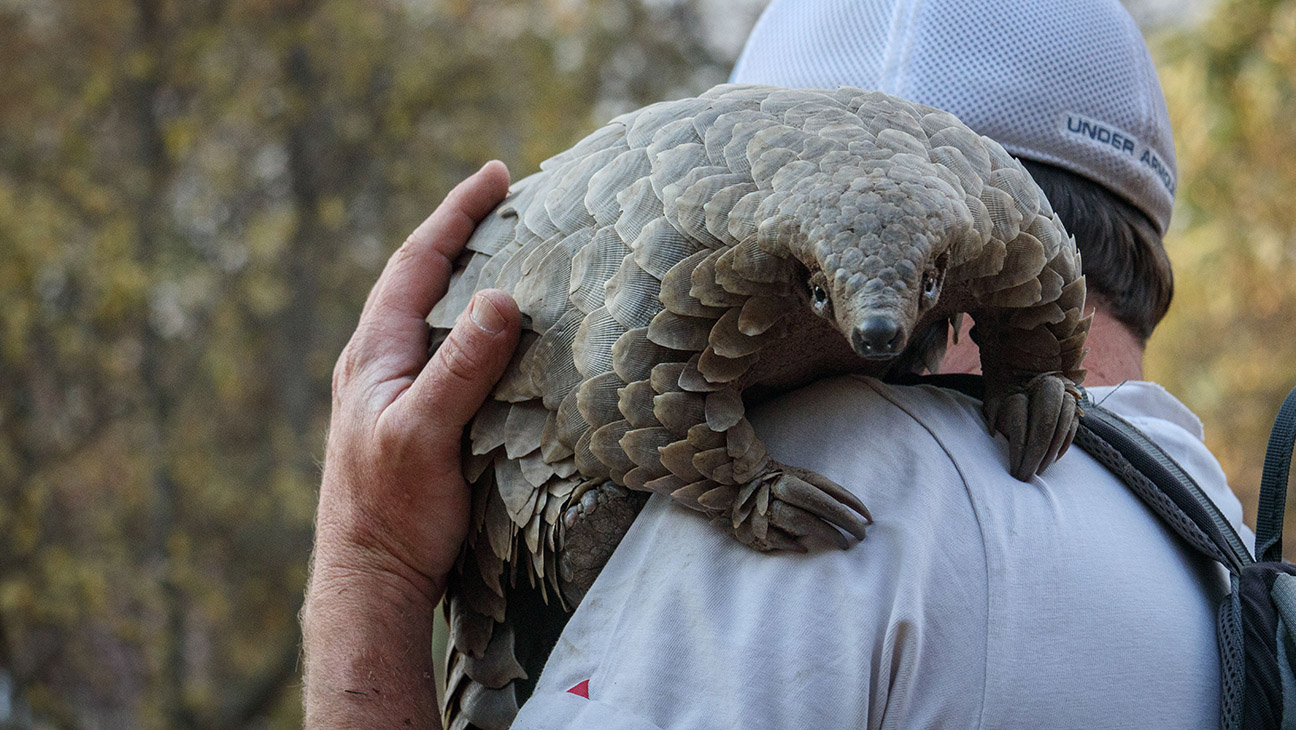
I hope you’re happy, Netflix, because now I want to raise a baby pangolin, and I probably won’t be alone. Which will be a challenge, given that it requires relocating to South Africa and signing up as a “Volunteer Pangolin Walker.” That job title is not one you often hear in a documentary, but it’s assigned here to Gareth Thomas, the human co-star of Pippa Ehrlich’s Pangolin: Kulu’s Journey. The My Octopus Teacher director delivers a variation on the formula of that 2021 Oscar winner, tracing the process by which a man seeking a more meaningful life finds it through extensive interaction with a generally antisocial animal.
Ehrlich’s new feature shares both strengths and weaknesses with the earlier doc. It eschews dry zoological study in favor of an engaging personal approach, but it can feel emotionally manipulative, its sentimentality amplified by a soundtrack featuring stirring African instrumentation and vocals. But the pangolin is such a unique beast — this one hilariously feisty and driven — and Thomas’ dedication to its care so touching that the captivating movie never loosens its hold.
Pangolin: Kulu’s Journey
The Bottom Line
A tad sentimental but impossible to resist.
Release date: Monday, April 21
Director: Pippa Ehrlich
Rated PG,
1 hour 28 minutes
Don’t beat yourself up if you’re wondering what the hell is a pangolin. It sounds like a cartoon penguin-mandolin hybrid and looks like a cross between an armadillo and an anteater.
According to the film, pangolins evolved with the dinosaurs and have been on Earth for 85 million years. The eight species that survive in parts of Asia and sub-Saharan Africa have become the world’s most trafficked wild mammals, harvested primarily for their hard, overlapping keratin scales, which are used in a range of traditional Chinese medicines. They are now at risk of extinction, heightening the importance of the anti-poaching and rehabilitation operations seen in the film.
To the Venda people of Southern Africa, the pangolin is “a gift from God,” with properties both mystical and magical. For generations, elders have passed down the myth that the animals descended from the sky and can make their protective scales vibrate to trigger thunder and bring rain. That folkloric significance is relayed in majestic opening footage of a nighttime thunderstorm as a pangolin ambles through scrubby underbrush, its armor glistening in the rain.
Johannesburg resident Thomas volunteers with the African Pangolin Working Group founded by ecology professor Ray Jansen, who serves as the lure, posing as a buyer in a sting operation to catch traffickers. The pup they rescue, initially named Gijima, is still a baby, too young to have been independent from his mother.
The only defense mechanism for pangolins is to roll up in a ball to protect their fleshy underbellies. Thomas has never seen one in the wild, only rescued pangolins; Jansen says they have almost reached “unicorn status.” But for poachers able to find the elusive mammals they are easy prey since they have poor vision and can’t bite or outrun a human. Some never recover from the trauma of being removed from their natural paradise and shoved into crates, dying before they can be nurtured back to health.
After Gijima is taken to Johannesburg Veterinary Hospital and from there to an offsite facility in an undisclosed location, Thomas is assigned to care for the terrified pup until he gains sufficient weight and strength to survive the “rewilding” process.
Jansen says APWG has released close to 100 rescued pangolins back into the wild, but the organization has had many losses, with some healthy pangolins not even surviving the first night. Some were taken by predators — lions, hyenas, leopards, that vicious WMD the honey badger — or died after contact with electric fences on the perimeters of nature reserves. Even after six months of rehabilitation, the stakes remain high.
Thomas is tasked with taking Gijima to a campsite in the Lapalala Wilderness Reserve, a vast conservation area that includes mountains, wetlands and grasslands, plus many different ant species and termites, the staples of a pangolin’s diet. The mammal’s experience with traffickers appears to make him hesitant to trust another human, so that process requires months of patience. Pangolins are solitary creatures, so Gijima’s instinct is to make a run for it whenever possible.
The pangolin walker adjusts his schedule to fit with his mostly nocturnal charge. He sets an alarm for 4 a.m. each morning and waits for the sound of Gijima scratching at the box in which he sleeps. The mammal will not feed on a plate of ants, eating only when he’s set down on the ground and given space to forage. A pangolin can smell an ant nest through a foot of hard earth.
It’s fun watching Gijima dig up ground with his front claws until he uncovers a colony and chows down in a feeding frenzy. He’s especially voracious with ant larvae, which Thomas refers to as “pangolin ice cream.” The pangolin has no mouth as such, just a funnel-like snout with a hole through which its long tongue appears at feeding time. When the ants start biting Gijima on the tongue, he uses his front claws to flick them off.
(Love that one common species is known as the “Pugnacious Ant” — ant whisperer Dr. Caswell Munyai is so fascinating he deserves his own doc.)
One of the more delightful discoveries about pangolins here is that they are freeloaders. Instead of digging their own burrows to sleep in, they look for holes dug by other animals — warthogs, aardvarks, bushpigs, porcupines — and modify them to fit their own needs. Kulu is also clever about self-protection, rolling around in rhino dung for scent disguise, because no animal wants to mess with a rhino.
Gradually, Gijima becomes calmer and more settled in the environment and begins to trust Thomas. His joy when the pangolin’s playful side emerges and he starts wrapping his tail around his keeper’s arm is infectious. Or the pangolin’s contortions of pleasure when he gets overheated and Thomas douses him with water.
There’s droll humor also in Thomas’ decision to rename him. Since “gijima” is the Zulu word for “run,” he figures the pangolin might be less inclined to bolt if he starts calling him “Kulu,” short for “kulula,” which means “easy.”
The film is as much Gareth’s journey as Kulu’s. I rolled my eyes when he talks about being able to show vulnerability around pangolins — “They don’t judge, they sort of see the real you” — but the anthropomorphism is mostly kept in check. And at least his bond with the animal is that of a self-described helicopter parent and eventual buddy, not the slightly cringey, quasi-sexualized interplay in My Octopus Teacher of diver Craig Foster with his favorite cephalopod. Enough with the tentacle fondling, get a room!
Thomas’ backstory is essential to this film’s reflections on the special relationships that can develop between humans and animals, in this case playing into the mythical notion of creatures with healing powers. A hyperactive kid who kept having to switch high schools, Thomas dropped out early and made a living playing poker. But the death of his two closest friends in a car accident set him adrift, which is how his association with APWG came about.
Irrespective of whether you go for nature docs in which the human element is almost as important as the fauna, it’s hard not to be carried along by the increasing emotional pull of Kulu’s Journey, especially once Thomas begins familiarizing him with the area where he will be released and prepares for the painful process of letting go. The separation anxiety will be familiar to any parent or pet owner.
There are setbacks and moments of suspense, notably when Kulu goes missing and fails to show up on the satellite tracker for two-and-a-half hours, an alarming weight loss when he starts covering large distances in the reserve and under-eating, or post-release, when he’s not seen for six days after getting trapped inside a collapsed burrow. Thomas’ anguish as he digs up ground expecting to find Kulu’s dead body is heart-wrenching, as is a gorgeous interaction earlier, in which the animal appears to be telling him he’s ready to go. Just hearing Thomas chatter away with the pangolin like a doting dad (“Stay in the shade”) is oddly endearing.
Like all good nature docs, the movie is laced with spectacular visuals, including a frequent motif of time-lapse skyscape vistas. The camera’s attention to the biodiversity of Lapalala yields stunning imagery, suitably accompanied by the gentle, chiming notes of Ann Nikitin’s score. I knew zero about pangolins before watching this film, but as corny as it sounds, I fell in love with the cute little fella by the end.
#Pangolin #Kulus #Journey #Review #Sweet #Netflix #Nature #Doc






